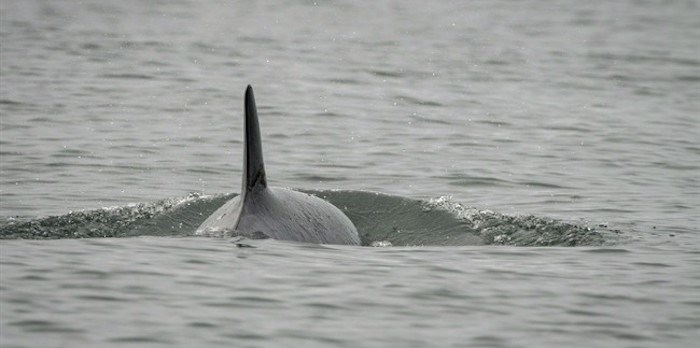Capturing and treating an extremely sick killer whale off the West Coast may be the next step in an attempt to nurse her back to health, say officials leading the operation in Canada and the United States.
If the young killer whale known as J50 is stranded on a beach or separated from her family, officials say they are laying out steps that would involve capturing and treating her before returning the animal to the wild.
 Killer whale J50 is shown off the coast of Washington State in this August 12, 2018 handout photo. An American whale research organization says an ailing killer whale has been found alive just hours after it was announced the young orca had been separated from her family pod.THE CANADIAN PRESS/HO – NOAA Fisheries, Katy Foster
Killer whale J50 is shown off the coast of Washington State in this August 12, 2018 handout photo. An American whale research organization says an ailing killer whale has been found alive just hours after it was announced the young orca had been separated from her family pod.THE CANADIAN PRESS/HO – NOAA Fisheries, Katy Foster
Chris Yates of the National Oceanic and Atmospheric Administration in the U.S. said the goal is for J50 to survive in the wild and contribute to the recovery of southern resident killer whales, which are an endangered species as only 75 remain.
"We do not intend to intervene or capture J50 in a manner contrary to that objective or when there is a negative impact to her pod or the wild population," he told a conference call with reporters on Wednesday.
"We are preparing along with our partners to rescue J50 if she is ultimately separated from her family unit or stranded and rescuing her is the only alternative before us."
Officials don't intend to intervene if she is with her pod, said Yates, the assistant regional administrator for protected resources with NOAA Fisheries.
Andrew Thomson, regional director of Fisheries and Oceans Canada, said it's a difficult situation.
"A lot of logistical challenges to consider, ensuring everyone is prepared for what can happen. We are trying to be in the best prepared position should a rescue be required through separation or stranding."
The latest aerial photos of the whale show a noticeable loss of fat behind the head, which creates a 'peanut head' appearance.
Veterinarian Joe Gaydos of the SeaDoc Society, a marine wildlife program at the University of California, Davis, saw J50 most recently and said she was in poor condition.
"She was the thinnest killer whale I've ever seen. But at that same time, she was still keeping up with her brother. Her mother was in the area. She was like this little Energizer Bunny that just keeps going and going."
He said body fat in a whale provides insulation and food, and also helps the animals swim more efficiently by providing a torpedo shape.
"So, she's reached a point now where she's working harder to move through the water than an animal in good condition. It's a very sick animal right now."
She's been given antibiotics twice, in August and September, but plans to give her a dewormer have not been successful. Officials are still hoping to administer a dose of dewormer.
A hands-on medical intervention would include doing a hearing test, an endoscopy, blood work and ultrasound, among other things.
Lynne Barre, the southern resident killer whale recovery co-ordinator for NOAA Fisheries, said should J50 be rescued and treated, one option would be rehabilitating her in a net pen for a period of time before she is reunited with her family.
![]()


